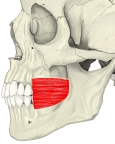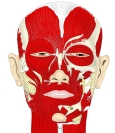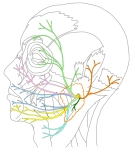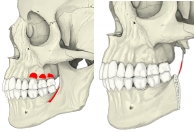頬 筋 ( きょうきん、 英 : buccinator muscle )
・ 概 要 |
・ 作 用 |
・ イラスト掲載サイ |
|
・ イラスト |
・ 神経 / 脈管 |
||
・ 起始 / 停止 |
・ Wikipedia |


・上顎の第2大臼歯の高さで 耳下腺管 (parotid duct) が貫通している。
・「 頬粘膜に密に結合しているが、皮膚との間は脂肪組織で隔てられている。」(船戸和弥のHP)
「頬筋は頬の筋性土台に該当し、口角部で口輪筋に付着する。頬筋は弓状に上顎骨歯槽突起の臼歯部、かつ下顎骨歯槽突起から起こる。上および下顎間は腱性の翼突下顎放線によって橋渡しされ、この放線もまた頬筋の起始である。上咽頭収縮筋の一部がこの放線の後部で起始する。口角付近で、線維索が交叉するので、頬の上方に位置する部分は下唇に広範囲わたって達することもあるし、達しないこともある。
頬筋は上顎の第2大臼歯のレベルで耳下腺管によって貫通され、しかも本筋は脂肪体からこれを隔てる浅筋膜(頬咽頭筋膜)を有する唯一の顔面筋である。頬筋は上・下歯列弓および頬粘膜間に入り込んだ植物片を再度歯列弓間に押し戻し、咀嚼および植物片のかたちづくりに重要な役割を果たしている。
本筋は口腔前庭を圧縮して、空気あるいは液体を口裂を通してふき出す(泡をふき出す、口笛をふく、吐き出す:“トランペット吹きの筋”)。両側の頬筋の収縮はは口角の外側部をくぼませる。
参考:この筋は頬粘膜に密に結合しているが、皮膚との間は脂肪組織で隔てられている。上顎第2大臼歯の高さで耳下腺管に貫かれる。 」

|

|
![]()
【 起 始 】: 上顎骨( 外側面の 歯槽隆起 )、下顎骨( 頬筋稜 )、 翼突下顎縫線
【 停 止 】: 口角には口輪筋に終わる。
「 口角を外側に引き口裂を閉じる。頬が満たされた状態では口腔内容を吹き出させる。( 例 : ラッパを吹くときなど )」( 日本人体解剖学 )
・ 神 経 : 顔面神経 の 頬筋枝 ( 日本人体解剖学 )
・ 脈 管 : おそらく顔面動脈・静脈 のいずれかの枝だと思われるが詳細は不明。

|
The buccinator (/?b?ks?ne?t?r/[2][3]) is a thin quadrilateral muscle occupying the interval between the maxilla and the mandible at the side of the face. It forms the anterior part of the cheek or the lateral wall of the oral cavity.[4]
It arises from the outer surfaces of the alveolar processes of the maxilla and mandible, corresponding to the three pairs of molar teeth and in the mandible, it is attached upon the buccinator crest posterior to the third molar ;[5] and behind, from the anterior border of the pterygomandibular raphe which separates it from the constrictor pharyngis superior.
The fibers converge toward the angle of the mouth, where the central fibers intersect each other, those from below being continuous with the upper segment of the orbicularis oris, and those from above with the lower segment; the upper and lower fibers are continued forward into the corresponding lip without decussation.
【 語 句 】
・ quadrilateral : 四辺形の ・ maxilla : 上顎骨 ・ mandible : 下顎骨 ・ oral cavity : 口腔 ・ alveolar processes : 歯槽突起 ・ molar teeth : 大臼歯 ・ buccinator crest : 頬筋稜 ・ pterygomandibular raphe : 翼突下顎縫線 ・ constrictor pharyngis superior : 上咽頭収縮筋 ・ converge : 集中する、収束する ・ angle of the mouth : 口角 ・ orbicularis oris : 口輪筋 ・ decussation : 交差
【 Innervation 】
Motor innervation is from the buccal branch of the facial nerve (cranial nerve VII ). Sensory innervation is supplied by the buccal branch ( one of the muscular branches ) of the mandibular part of the trigeminal ( cranial nerve V ).[6]
Its purpose is to pull back the angle of the mouth and to flatten the cheek area, which aids in holding the cheek to the teeth during chewing. This action causes the muscle to keep food pushed back on the occlusal surface of the posterior teeth, as when a person chews. By keeping the food in the correct position when chewing, the buccinator assists the muscles of mastication.[4]
It aids whistling and smiling, and in neonates it is used to suckle.
【 語 句 】
・ buccal branch of the facial nerve : 顔面神経の頬筋枝 ・ cranial nerve : 脳神経 ・ trigeminal : 三叉神経 ・ occlusal : 咬合性の ・ mastication : 咀嚼 ・ neonate : 新生児 ・ suckle : 乳を飲む



